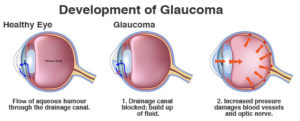Glaucoma Facts
- Glaucoma is the leading cause of irreversible blindness worldwide.
- One in eight Australians over 80 will develop glaucoma.
- First degree relatives of glaucoma patients have an ten-fold increased risk of developing the disease.
- 50% of people with glaucoma in Australia are undiagnosed.
- Australian health care cost of glaucoma in 2005 was $342 million.
- The total annual cost of glaucoma in 2005 was $1.9 billion.
- The total cost is expected to increase to $4.3 billion by 2025.
What is glaucoma?
Glaucoma is the name given to a group of eye diseases in which the optic nerve at the back of the eye is slowly destroyed. In most people this damage is due to an increased pressure inside the eye - a result of blockage of the circulation of aqueous, or its drainage. In other patients the damage may be caused by poor blood supply to the vital optic nerve fibres, a weakness in the structure of the nerve, and/or a problem in the health of the nerve fibres themselves.
Over 300,000 Australians have glaucoma. While it is more common as people age, it can occur at any age. As our population becomes older, the proportion of glaucoma patients is increasing.
Who is at risk?
Although anyone can get glaucoma, some people have a higher risk, those with
- Family history of glaucoma
- Diabetes
- Migraines
- Short sightedness (myopia)
- Long sightedness (hyperopia)
- Eye injuries
- High blood pressure
- Past or present use of cortisone drugs (steroids)
People in these groups should have their first eye check no later than the age of 35. For most people, it is recommended to have an eye check for glaucoma by the age of 40. If no glaucoma is found, the NHMRC (2010) Guidelines recommend regular eye health checks for Caucasians over the age of 50 & for those of African & Asian descent over the age of 40 years, because of the higher prevalence in the latter groups. Losing vision means losing life.
Left untreated and undiagnosed, glaucoma can lead to blindness. Now the revolutionary new Nidek RS 3000 Optical coherence tomographer (OCT) exam gives the optometrist information about your eyes that no other glaucoma test can provide.
Ask your optometrist about this safe and simple test today, and keep glaucoma from sneaking up on you.


